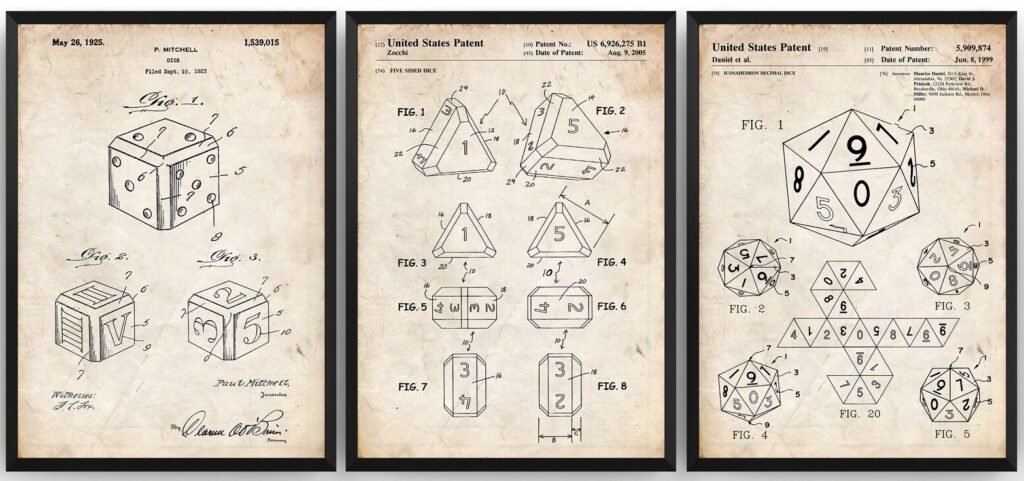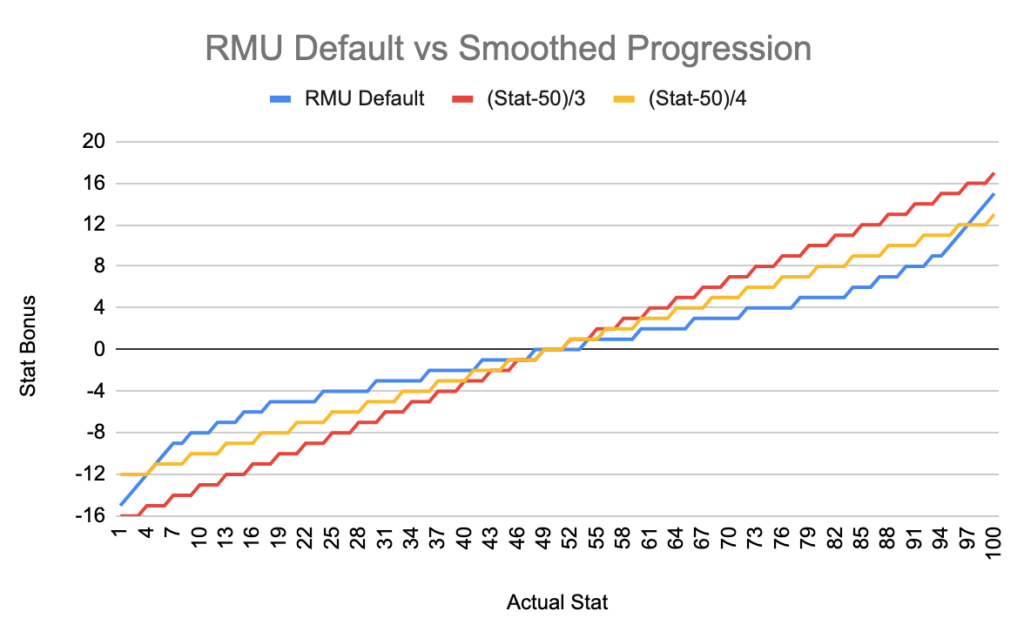RMU is finally out! After years of waiting, we finally have a finished (sort of) product, so the best thing I could think to do to honor this moment is to immediately start assessing its rules and suggesting tweaks! This will hopefully be the first post in a series of RMU rules evaluations.

The rule under discussion today has to do with the way stats function in this latest iteration of Rolemaster. Unsurprisingly for those of us who have been tracking its progress, the “old” model of stats is preserved, with characters having temporary stats with determine bonuses for use in skills, and potential stats that serve as caps that the temporaries can grow towards.
This won’t be anything that some others haven’t discussed before, but I too have a handful of issues with the stat system as it is currently configured. Here are some of the gripes:
1️⃣ Rolling for Stats – This actually isn’t a gripe and I’m curious where people fall on this issue; for years I was a stat-rolling loyalist. RMU does give the option to use stat-buy and I have converted to that camp. I like that all players start on equal footing, so I’m already using one of RMU’s optional rules.
2️⃣ Potential Stats – This is actually one of the bigger issues I have, in that I’m not sure potential stats have much functionality. D&D doesn’t have them, and even with stat raises each level, characters don’t typically max out all their stats until pretty far into the leveling process.
My solution? I’m ditching them. All stats now have a “potential” of 100, so if a character wants to focus on developing one or two stats to the exclusion of others, so be it. With most skills drawing from three different stat bonuses, I think the effect will be negligible.
3️⃣ Smoothing the Stat Progression (even more) – RMU features a much smoother bonus curve compared to old RM2, but still requires referencing a table, and still has big spikes at the high and low ends. I suppose my question is why? Is this more realistic in depicting real-world ability progression?

On the ICE forums, Hurin has advocated for a simpler formula for stat bonuses that is easy to remember: (Stat-50)/3. This gives a simple linear progression that requires one less chart. I have actually toyed with a variation on this of (Stat-50)/4 which brings the stats a little closer to the RMU default curve, but this progression also rewards bigger bonuses before characters hike stats into the 90s. Again, simple is better and either one doesn’t seem to affect game balance.
4️⃣ Standardizing Stat Gains – As in prior versions, each player gets two stat gains each level, with the amount now partially determined by the stat itself, rather than the difference between the temporary and potential. You still roll however for the amount gained. Here’s another element where chance can separate players rather than choices made in character development.
As a result, I’m putting in standardized stat raises. Each level, two stats can be raised by a +1 bonus — the stats themselves then raise by the corresponding amount each level, whether using RMU’s curve of the smoothed progression, but the bonus is what really matters). This actually brings up another issue of whether we even need stats at all, since really all they do is provide bonuses. I believe a few of our RMU play-testers have gotten rid of them completely and just have players purchase bonuses, but I actually like seeing stats purely as a visual of the character as a whole and how they compare to the rest of the population.
So there’s my thoughts and rulings on just one aspect of the final RMU rules. My house rule fixes aren’t too drastic, and are centered on taking chance out of character development. Players deal with enough chance already due to the fall of the dice during adventuring, so any chance I have to take away another gripe of life’s RNG seems like a good thing to me.
Thoughts? Any surprises for anyone in the finalized version of RM Core Law?

Given how stats function in RM writ large (to include RMU), I still think they have too many. This is especially true now that they don’t contribute in any real way to DPs or the like. I’m torn on the idea of only having bonuses for them…mainly because I have used raw stats in my games before. I can’t say I’ve ever really been a fan of stat gain rolls, but given the basic mechanics of RMU there’s really no other way to do it that doesn’t throw things out of balance.
While it’s nice to see they have stat purchase as an option, I won’t be using it. I’ve never been a fan of purchase systems (as either a GM or player) for a number of reasons. At least they made it an option as opposed to the default system.
Stats/Attributes: I feel a bit uneasy about the trend away from the core attributes/stats. While I understand they seem confusing to a new player’s eye, I feel they give a foundational basis for the system, lending nuance and reason that would be lost otherwise. While I never fully embraced the ‘+ forward’ nature of d20 games, once I started playing PF2e I have to admit there is a lot to like about the ease of understanding. Shockingly enough, I’ve gradually come around to the opinion that Stats/Attributes don’t even need to appear on the first page of a character sheet. If the system doesn’t directly interface with them, why confuse players with clutter that doesn’t immediately impact table play? Put them on a ‘reference’ sheet somewhere else to look up when they level.
The Optional Point Buy System (PBS): I’m fine with it, and a number of systems implement that now (PF2e for one). It helps to balance a starting party, and minimize randomization issues. However RMu’s option in which the PC buy’s their temps, and rolls Potentials is frankly clunky, ill thought out, and complicates an otherwise acceptable mechanic. How many rolls? What do you discard? “I’m buying one thing, but rolling another?”
Potentials: I like them, and always have considered them a strength of the system. All of us know that in previous versions of RM, Potentials served to offset low initial scores. So even if a PC rolled a 35 for some stat, they had a reasonable assurance that a) its potential would help offset that initial deficiency, and b) it could increase pretty quickly. Coupled with a good Stat Gain system (IMHO, RMC’s ‘diff’ version is the Gold Standard), it allowed for continued growth in stats away from the ‘core’ abilities that most lv1 players focus on. I have no idea how a Point Buy system could incorporate Potentials, but I find it a glaring shame that it didn’t find at least some way of doing so.
Smoothed Progression: Very nice.
Standardized Stat Gain: As a 1:1 replacement of RMU’s Stat Gain (SG) table, sure. However I’m not a fan of RMU’s SG at all. To my eye, that enormous 60 stat ‘d10 ‘ range in the middle of the table penalizes lower stats, and boosts the larger stats too much. I’ve been playing with a simple 10% difference rule for SG. The player gets 10% of the difference between 100 (or their potential) and their temp stat (rounded up). Without potentials: An initial stat of 23 gets 8 points (100 – 23 = 77, 10% of which is 7.7, rounded to 8). The next gain they would get 7 (100-31=69, or 6.9 rounded to 7). If the PC’s temp stat is 86, then they get 2 points to their stat (14 difference, so 1.4, rounded up to 2). Sure it’s more generic and bland, but it does eliminates a table and I find is easy to remember.
copied from discord thread for preservation:
re: potentials
Because not everyone is equally capable.
Spend the same time in the gym, not everyone will hit the same maximums.
Spend as much time hitting the books, some people won’t recall the same amount.
Spend as much time doing math, Venn diagrams, binary algebra, not everyone will logic to the same degree.
Potentials represent the fact that we are all different by nature, not just nurture. In fact I would propose that removing potentials is a setting cosmology aspect.
Thus, I am not saying don’t remove them, but I am saying they are not just an annoying part of character creation/advancement. They are a subtle and realistic representation.
I do like and always have the Stat Potentials in Rolemaster, it just makes it different. Maybe the stats themselves don’t need to be on front page of the character sheet, just he bonuses, that is an interesting idea.
The smooth stat bonuses is also something that is interesting, I like the smoothed stats from RMC1.
I do like the option of the point by system, but yes the roll lots of dice to then discard 20 rolls seem silly, there was an option I am sure in the Beta, that all Potentials started at 100, it will take some time for all the stats to rise that high. I also miss the chance of a stat dropping I need to see how that could be brought in to RMU, that is always the gamble.
The Stat gain table also needs some work, I like the 10% option too.
One reason to prefer (Stat – 50)/3 over (Stat – 50)/4 is that the former allows for higher bonuses, especially at the top (+17 vs +13). I find stat bonuses are especially helpful at the lower levels (and lower levels in RMU can be challenging), when characters don’t yet have high skill bonuses.